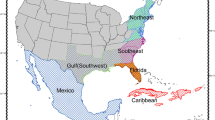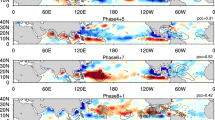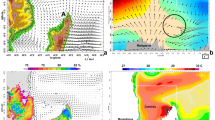Abstract
This study examines the year-to-year modulation of the western North Pacific (WNP) tropical cyclones (TC) activity by the Atlantic Meridional Mode (AMM) using both observations and the Geophysical Fluid Dynamics Laboratory Forecast-oriented Low Ocean Resolution Version of CM2.5 (FLOR) global coupled model. 1. The positive (negative) AMM phase suppresses (enhances) WNP TC activity in observations. The anomalous occurrence of WNP TCs results mainly from changes in TC genesis in the southeastern part of the WNP. 2. The observed responses of WNP TC activity to the AMM are connected to the anomalous zonal vertical wind shear (ZVWS) caused by AMM-induced changes to the Walker circulation. During the positive AMM phase, the warming in the North Atlantic induces strong descending flow in the tropical eastern and central Pacific, which intensifies the Walker cell in the WNP. The intensified Walker cell is responsible for the suppressed (enhanced) TC genesis in the eastern (western) part of the WNP by strengthening (weakening) ZVWS. 3. The observed WNPTC–AMM linkage is examined by the long-term control and idealized perturbations experiment with FLOR-FA. A suite of sensitivity experiments strongly corroborate the observed WNPTC–AMM linkage and underlying physical mechanisms.











Similar content being viewed by others
References
Camargo SJ, Sobel AH (2005) Western North Pacific tropical cyclone intensity and ENSO. J Clim 18:2996–3006
Camargo SJ, Emanuel KA, Sobel AH (2007a) Use of a genesis potential index to diagnose ENSO effects on tropical cyclone genesis. J Clim 20:4819–4834
Camargo SJ, Sobel AH, Barnston AG, Emanuel KA (2007b) Tropical cyclone genesis potential index in climate models. Tellus A 59:428–443
Carton JA, Cao X, Giese BS, Da Silva AM (1996) Decadal and interannual SST variability in the tropical Atlantic Ocean. J Phys Oceanogr 26:1165–1175
Chan JCL (1985) Tropical cyclone activity in the Northwest Pacific in relation to the El Niño Southern Oscillation phenomenon. Mon Weather Rev 113:599–606
Chan JCL (2000) Tropical cyclone activity over the western North Pacific associated with El Niño and La Niña events. J Clim 13:2960–2972
Chan JCL, Liu KS (2004) Global warming and western North Pacific typhoon activity from an observational perspective. J Clim 17:4590–4602
Chan JCL, Shi J, Liu KS (2001) Improvements in the seasonal forecasting of tropical cyclone activity over the Western North Pacific. Weather Forecast 16:491–498
Chang P, Ji L, Li H (1997) A decadal climate variation in the tropical Atlantic Ocean from thermodynamic air–sea interactions. Nature 385:516–518
Chiang JCH, Vimont DJ (2004) Analogous Pacific and Atlantic Meridional Modes of tropical atmosphere–ocean variability*. J Clim 17:4143–4158
Chiang JCH, Kushnir Y, Giannini A (2002) Deconstructing Atlantic intertropical convergence zone variability: influence of the local cross-equatorial sea surface temperature gradient and remote forcing from the eastern equatorial Pacific. J Geophys Res Atmos 107:ACL 3-1–ACL 3-19
Choi Y, Ha K-J, Ho C-H, and Chung C (2015) Interdecadal change in typhoon genesis condition over the western North Pacific. Clim Dyn 45:3243–3255
Delworth TL, Broccoli AJ, Rosati A, Stouffer RJ, Balaji V, Beesley JA, Cooke WF, Dixon KW, Dunne J, Dunne KA, Durachta JW, Findell KL, Ginoux P, Gnanadesikan A, Gordon CT, Griffies SM, Gudgel R, Harrison MJ, Held IM, Hemler RS, Horowitz LW, Klein SA, Knutson TR, Kushner PJ, Langenhorst AR, Lee H-C, Lin S-J, Lu J, Malyshev SL, Milly PCD, Ramaswamy V, Russell J, Schwarzkopf MD, Shevliakova E, Sirutis JJ, Spelman MJ, Stern WF, Winton M, Wittenberg AT, Wyman B, Zeng F, Zhang R (2006) GFDL’s CM2 global coupled climate models. Part I: formulation and simulation characteristics. J Clim 19:643–674
Delworth TL, Rosati A, Anderson W, Adcroft AJ, Balaji V, Benson R, Dixon K, Griffies SM, Lee H-C, Pacanowski RC, Vecchi GA, Wittenberg AT, Zeng F, Zhang R (2012) Simulated climate and climate change in the GFDL CM2.5 high-resolution coupled climate model. J Clim 25:2755–2781
Deser C, Wallace JM (1987) El Niño events and their relation to the Southern Oscillation: 1925–1986. J Geophys Res Oceans 92:14189–14196
Doi T, Vecchi GA, Rosati AJ, Delworth TL (2013) Response to CO2 doubling of the Atlantic hurricane main development region in a high-resolution climate model. J Clim 26:4322–4334
Du Y, Yang L, Xie S-P (2010) Tropical Indian Ocean influence on northwest Pacific tropical cyclones in summer following strong El Niño*. J Clim 24:315–322
Emanuel KA and Nolan D (2004) Tropical cyclone activity and the global climate system. Preprints, 26th conference on hurricanes and tropical meteorology. American Meteorological Society A, Miami, FL
England MH, McGregor S, Spence P, Meehl GA, Timmermann A, Cai W, Gupta AS, McPhaden MJ, Purich A, Santoso A (2014) Recent intensification of wind-driven circulation in the Pacific and the ongoing warming hiatus. Nat Clim Change 4:222–227
Fan K, Wang H (2009) A new approach to forecasting typhoon frequency over the western North Pacific. Weather Forecast 24:974–986
Girishkumar MS, Thanga Prakash VP, Ravichandran M (2014) Influence of Pacific decadal oscillation on the relationship between ENSO and tropical cyclone activity in the Bay of Bengal during October–December. Clim Dyn 44:3469–3479
Gray WM (1979) Hurricanes: their formation, structure and likely role in the tropical circulation. Meteorol Trop Oceans 77:155–218
Grossmann I, Klotzbach PJ (2009) A review of North Atlantic modes of natural variability and their driving mechanisms. J Geophys Res 114:D24107. doi:10.1029/2009JD012728
Ham Y-G, Kug J-S, Park J-Y, Jin F-F (2013) Sea surface temperature in the north tropical Atlantic as a trigger for El Niño/Southern Oscillation events. Nat Geosci 6:112–116
He H, Yang J, Gong D, Mao R, Wang Y, Gao M (2015) Decadal changes in tropical cyclone activity over the western North Pacific in the late 1990s. Clim Dyn 45:3317–3329
Huo L, Guo P, Hameed SN, Jin D (2015) The role of tropical Atlantic SST anomalies in modulating western North Pacific tropical cyclone genesis. Geophys Res Lett 42:2378–2484
Jia L, Yang X, Vecchi GA, Gudgel RG, Delworth TL, Rosati A, Stern WF, Wittenberg AT, Krishnamurthy L, Zhang S, Msadek R, Kapnick S, Underwood S, Zeng F, Anderson WG, Balaji V, Dixon K (2015) Improved seasonal prediction of temperature and precipitation over land in a high-resolution GFDL climate model. J Clim 28:2044–2062
Kalnay E, Kanamitsu M, Kistler R, Collins W, Deaven D, Gandin L, Iredell M, Saha S, White G, Woollen J (1996) The NCEP/NCAR 40-year reanalysis project. Bull Am Meteorol Soc 77:437–471
Kang I-S, No H-H, Kucharski F (2014) ENSO amplitude modulation associated with the mean SST changes in the tropical central Pacific induced by Atlantic Multidecadal Oscillation. J Clim 27:7911–7920
Kennedy JJ, Rayner NA, Smith RO, Parker DE, Saunby M (2011) Reassessing biases and other uncertainties in sea surface temperature observations measured in situ since 1850: 2 Biases and homogenization. J Geophys Res Atmos 116:D14104
Kim H-S, Vecchi GA, Knutson TR, Anderson WG, Delworth TL, Rosati A, Zeng F, Zhao M (2014) Tropical cyclone simulation and response to CO2 doubling in the GFDL CM2.5 high-resolution coupled climate model. J Clim 27:8034–8054
Klotzback PJ (2007) Recent developments in statistical prediction of seasonal Atlantic basin tropical cyclone activity. Tellus B Dyn Meteorol Oceanogr 59:511–518
Knapp KR, Kruk MC, Levinson DH, Diamond HJ, Neumann CJ (2010) The international best track archive for climate stewardship (IBTrACS). Bull Am Meteorol Soc 91:363–376
Kobayashi S, Ota Y, Harada Y, Ebita A, Moriya M, Onoda H, Onogi K, Kamahori H, Kobayashi C, Endo H, Miyaoka K, Takahashi K (2015) The JRA-55 reanalysis: general specifications and basic characteristics. J Meteorol Soc Jpn Ser II 93:5–48
Kossin JP, Vimont DJ (2007) A more general framework for understanding Atlantic hurricane variability and trends. Bull Am Meteorol Soc 88:1767–1781
Kucharski F, Kang IS, Farneti R, Feudale L (2011) Tropical Pacific response to 20th century Atlantic warming. Geophys Res Lett 38:L03702. doi:10.1029/2010GL046248
Kucharski F et al (2016) Atlantic forcing of Pacific decadal variability. Clim Dyn. doi:10.1007/s00382-015-2705-z
Lee HS, Yamashita T, Mishima T (2012) Multi-decadal variations of ENSO, the Pacific Decadal Oscillation and tropical cyclones in the western North Pacific. Prog Oceanogr 105:67–80
Li X, Yang S, Wang H, Jia X, Kumar A (2013) A dynamical-statistical forecast model for the annual frequency of western Pacific tropical cyclones based on the NCEP Climate Forecast System version 2. J Geophys Res Atmos 118:12061–12074
Li X, Xie S-P, Gille ST, Yoo C (2015) Atlantic-induced pan-tropical climate change over the past three decades. Nat Clim Change 6:275–279
Lin II, Chan JCL (2015) Recent decrease in typhoon destructive potential and global warming implications. Nat Commun 6:7182. doi:10.1038/ncomms8182
Liu KS, Chan JCL (2012) Inactive period of western North pacific tropical cyclone activity in 1998–2011. J Clim 26:2614–2630
McGregor S, Timmermann A, Stuecker MF, England MH, Merrifield M, Jin F-F, Chikamoto Y (2014) Recent Walker circulation strengthening and Pacific cooling amplified by Atlantic warming. Nat Clim Change 4:888–892
Mitchell CL (1932) West Indian hurricanes and other tropical cyclones of the North Atlantic Ocean. Mon Weather Rev 60:253
Murakami H, Vecchi GA, Underwood S, Delworth T, Wittenberg AT, Anderson W, Chen J-H, Gudgel R, Harris L, Lin S-J, Zeng F (2015) Simulation and prediction of Category 4 and 5 hurricanes in the high-resolution GFDL HiFLOR coupled climate model. J Clim 28:9058–9079
Nobre P, Shukla J (1996) Variations of sea surface temperature, wind stress, and rainfall over the tropical Atlantic and south America. J Clim 9:2464–2479
Pielke R Jr, Gratz J, Landsea C, Collins D, Saunders M, Musulin R (2008) Normalized hurricane damage in the United States: 1900–2005. Nat Hazards Rev 9:29
Rappaport EN (2000) Loss of life in the United States associated with recent Atlantic tropical cyclones. Bull Am Meteorol Soc 81:2065–2073
Servain J (1991) Simple climatic indices for the tropical Atlantic Ocean and some applications. J Geophys Res Oceans 96:15137–15146
Smirnov D, Vimont DJ (2011) Variability of the Atlantic Meridional Mode during the Atlantic hurricane season. J Clim 24:1409–1424
Smirnov D, Vimont DJ (2012) Extratropical forcing of tropical Atlantic variability during the boreal summer and fall. J Clim 25:2056–2076
Tu JY, Chou C, Chu PS (2009) The abrupt shift of typhoon activity in the vicinity of Taiwan and its association with western North Pacific-East Asian climate change. J Clim 22:3617–3628
Vecchi GA, Soden BJ (2007) Effect of remote sea surface temperature change on tropical cyclone potential intensity. Nature 450:1066–1070
Vecchi GA, Delworth T, Gudgel R, Kapnick S, Rosati A, Wittenberg AT, Zeng F, Anderson W, Balaji V, Dixon K, Jia L, Kim HS, Krishnamurthy L, Msadek R, Stern WF, Underwood SD, Villarini G, Yang X, Zhang S (2014) On the seasonal forecasting of regional tropical cyclone activity. J Clim 27:7994–8016
Vimont DJ, Kossin JP (2007) The Atlantic Meridional Mode and hurricane activity. Geophys Res Lett 34:L07709
Vitart FD, Stockdale TN (2001) Seasonal forecasting of tropical storms using coupled GCM integrations. Mon Weather Rev 129:2521–2537
Wang B, Chan JCL (2002) How strong ENSO events affect tropical storm activity over the Western North Pacific. J Clim 15:1643–1658
Wu GX, Lau NC (1992) A GCM simulation of the relationship between tropical–storm formation and ENSO. Mon Weather Rev 120:958–977
Wu L, Wang C, Wang B (2015) Westward shift of western North Pacific tropical cyclogenesis. Geophys Res Lett 42:1537–1542
Xie S-P, Philander SGH (1994) A coupled ocean-atmosphere model of relevance to the ITCZ in the eastern Pacific. Tellus A 46:340–350
Yang X, Vecchi GA, Gudgel RG, Delworth TL, Zhang S, Rosati A, Jia L, Stern WF, Wittenberg AT, Kapnick S, Msadek R, Underwood SD, Zeng F, Anderson W, Balaji V (2015) Seasonal predictability of extratropical storm tracks in GFDL’s high-resolution climate prediction model. J Clim 28:3592–3611
Yu J-Y, Kao P-K, Paek H, Hsu H-H, Hung C-W, Lu M-M, An S-I (2014) Linking emergence of the central Pacific El Niño to the Atlantic multidecadal oscillation. J Clim 28:651–662
Yu J, Li T, Tan Z, Zhu Z (2015) Effects of tropical North Atlantic SST on tropical cyclone genesis in the western North Pacific. Clim Dyn 46:865–877
Zhan R, Wang Y, Lei X (2010) Contributions of ENSO and East Indian Ocean SSTA to the interannual variability of northwest Pacific tropical cyclone frequency*. J Clim 24:509–521
Zhan R, Wang Y, Tao L (2014) Intensified impact of East Indian Ocean SST anomaly on tropical cyclone genesis frequency over the western North Pacific. J Clim 27:8724–8739
Zhang R, Delworth TL (2007) Impact of the Atlantic multidecadal oscillation on North Pacific climate variability. Geophys Res Lett 34:L23708
Zhang L, Zhao C (2015) Processes and mechanisms for the model SST biases in the North Atlantic and North Pacific: a link with the Atlantic meridional overturning circulation. J Adv Model Earth Syst 7:739–758
Zhang Q, Liu Q, Wu L (2009) Tropical cyclone damages in China 1983–2006. Bull Am Meteorol Soc 90:489–495
Zhang W, Graf HF, Leung Y, Herzog M (2012) Different El Niño types and tropical cyclone landfall in East Asia. J Clim 25:6510–6523
Zhang W, Leung Y, Min J (2013) North Pacific Gyre Oscillation and the occurrence of western North Pacific tropical cyclones. Geophys Res Lett 40(19):5205–5211
Zhang H, Deser C, Clement A, Tomas R (2014) Equatorial signatures of the Pacific meridional modes: dependence on the mean climate state. Geophys Res Lett 41:568–574. doi:10.1002/2013GL058842
Zhang W, Leung Y, Fraedrich K (2015) Different El Niño types and intense typhoons in the Western North Pacific. Clim Dyn 11–12:2965–2977
Zhang W, Vecchi G, Murakami H, Villarini G, Jia L (2016a) The Pacific meridional mode and the occurrence of tropical cyclones in the Western North Pacific. J Clim 29:381–398
Zhang W, Vecchi GA, Murakami H, Delworth T, Wittenberg AT, Anderson W, Rosati A, Underwood S, Harris L, Gudgel R, Lin S-J, Villarini G, Chen J-H (2016b) Improved simulation of tropical cyclone responses to ENSO in the Western North Pacific in the high-resolution GFDL HiFLOR coupled climate model. J Clim 29:1391–1415
Acknowledgments
The authors are grateful to Jim Kossin and an anonymous reviewer for their insightful comments that improve this paper. The authors thank Lakshmi Krishnamurthy and Honghai Zhang for their comments that improve an earlier version of this manuscript. This material is based in part upon work supported by the National Science Foundation under Grants AGS-1262091 and AGS-1262099.
Author information
Authors and Affiliations
Corresponding author
Appendix
Appendix
TCs in FLOR are tracked from 6-hourly model output by using the tracker developed at GFDL and this tracker has been implemented in Murakami et al. (2015) and Zhang et al. (2016a, b). The temperature anomaly averaged vertically over 300 and 500 hPa (ta), 10 m wind speed, 850 hPa relative vorticity and sea level pressure (SLP) are key factors of this tracker. The tracking procedures are as follows.
-
1.
Find local minima of the smoothed SLP field. The location of the cyclone center is properly adjusted by fitting a biquadratic surface to the SLP and locating the center at the minima.
-
2.
Closed contours are in an interval of 2 hPa (dp) around every single low center. The Nth contour is marked as the contiguous region surrounding a low central pressure P with pressures lower than dp × N + P, as detected by a “flood fill” algorithm. Note that the contours are not required to be circular and a maximum radius of 3,000 km is searched from each candidate SLP low center.
-
3.
If the above closed contours are found, the low is counted as a TC center. In this way, the tracker attempts to find all closed contours within a certain distance of the low center and without entering contours belonging to another low. The maximum 10-m wind inside the set of closed contours is taken as the maximum wind speed at that time for the storm.
-
4.
Warm cores are detected via similar processes: closed 1 K contours are found surrounding the maximum ta within a TC’s identified contours, no more than 1 degree from the low center. This contour must have a radius smaller than 3 degrees in distance. If such a core is not found, it is not considered as a warm-core low center and the center is rejected.
-
5.
TC centers are combined into a TC track by taking a low center at time T−dt, extrapolating its motion forward dt, and then seeking for storms within 750 km. A deeper low center has higher priority of tracking.
-
6.
The following criteria are required to finalize the TC identifications.
-
(a)
At least 72 h of total detection lifetime (not necessarily consecutive).
-
(b)
At least 48 cumulative (not necessarily consecutive) hours with a warm core.
-
(c)
At least 36 consecutive hours of a warm core with winds greater than 17.5 ms−1.
-
(d)
TC genesis should be confined equatorward of 40°N.
-
(a)
TC track/genesis density in the WNP is binned into 5° × 5° grid boxes at a 6-h interval without smoothing.
Rights and permissions
About this article
Cite this article
Zhang, W., Vecchi, G.A., Villarini, G. et al. Modulation of western North Pacific tropical cyclone activity by the Atlantic Meridional Mode. Clim Dyn 48, 631–647 (2017). https://doi.org/10.1007/s00382-016-3099-2
Received:
Accepted:
Published:
Issue Date:
DOI: https://doi.org/10.1007/s00382-016-3099-2




